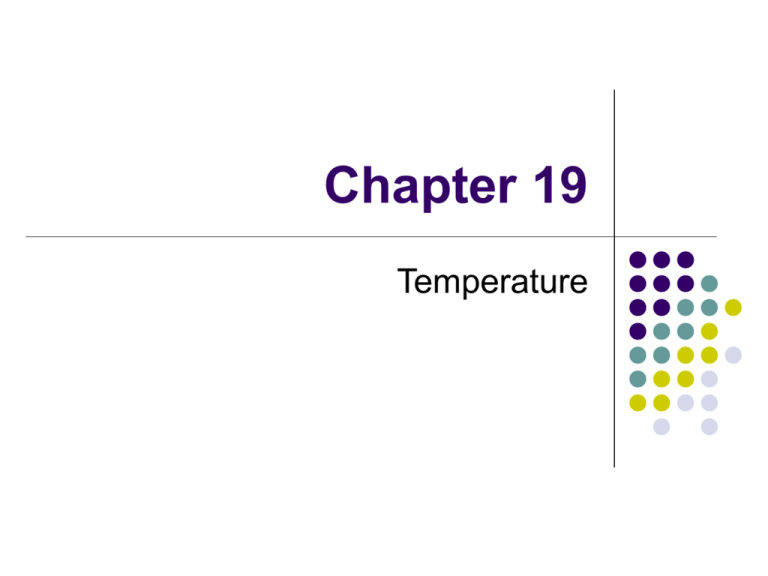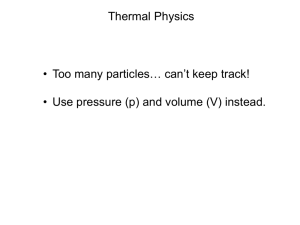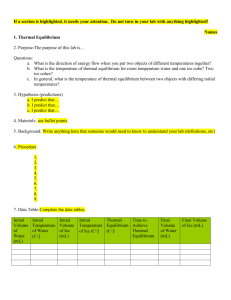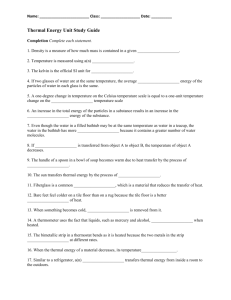chapter19
advertisement

Chapter 19 Temperature Temperature We associate the concept of temperature with how hot or cold an object feels Our senses provide us with a qualitative indication of temperature Our senses are unreliable for this purpose We need a reliable and reproducible method for measuring the relative hotness or coldness of objects We need a technical definition of temperature Thermal Contact Two objects are in thermal contact with each other if energy can be exchanged between them The exchanges we will focus on will be in the form of heat or electromagnetic radiation The energy is exchanged due to a temperature difference Thermal Equilibrium Thermal equilibrium is a situation in which two objects would not exchange energy by heat or electromagnetic radiation if they were placed in thermal contact The thermal contact does not have to also be physical contact Zeroth Law of Thermodynamics If objects A and B are separately in thermal equilibrium with a third object C, then A and B are in thermal equilibrium with each other Let object C be the thermometer Since they are in thermal equilibrium with each other, there is no energy exchanged among them Zeroth Law of Thermodynamics, Example Object C (thermometer) is placed in contact with A until they achieve thermal equilibrium Object C is then placed in contact with object B until they achieve thermal equilibrium The reading on C is recorded The reading on C is recorded again If the two readings are the same, A and B are also in thermal equilibrium Temperature – Definition Temperature can be thought of as the property that determines whether an object is in thermal equilibrium with other objects Two objects in thermal equilibrium with each other are at the same temperature If two objects have different temperatures, they are not in thermal equilibrium with each other Thermometers A thermometer is a device that is used to measure the temperature of a system Thermometers are based on the principle that some physical property of a system changes as the system’s temperature changes Thermometers, cont These properties include: The volume of a liquid The dimensions of a solid The pressure of a gas at a constant volume The volume of a gas at a constant pressure The electric resistance of a conductor The color of an object A temperature scale can be established on the basis of any of these physical properties Thermometer, Liquid in Glass A common type of thermometer is a liquid-in-glass The material in the capillary tube expands as it is heated The liquid is usually mercury or alcohol Calibrating a Thermometer A thermometer can be calibrated by placing it in contact with some natural systems that remain at constant temperature Common systems involve water A mixture of ice and water at atmospheric pressure Called the ice point of water A mixture of water and steam in equilibrium Called the steam point of water Once these points are established, the length between them can be divided into a number of segments Celsius Scale The ice point of water is defined to be 0o C The steam point of water is defined to be 100o C The length of the column between these two points is divided into 100 increments, called degrees Problems with Liquid-in-Glass Thermometers An alcohol thermometer and a mercury thermometer may agree only at the calibration points The discrepancies between thermometers are especially large when the temperatures being measured are far from the calibration points The thermometers also have a limited range of values that can be measured Mercury cannot be used under –39o C Alcohol cannot be used above 85o C Constant-Volume Gas Thermometer The physical change exploited is the variation of pressure of a fixed volume gas as its temperature changes The volume of the gas is kept constant by raising or lowering the reservoir B to keep the mercury level at A constant Constant-Volume Gas Thermometer, cont The pressure is indicated by the height difference between reservoir B and column A The thermometer is calibrated by using a ice water bath and a steam water bath The pressures of the mercury under each situation are recorded The volume is kept constant by adjusting A The information is plotted Constant-Volume Gas Thermometer, final To find the temperature of a substance, the gas flask is placed in thermal contact with the substance The pressure is found on the graph The temperature is read from the graph Absolute Zero The thermometer readings are virtually independent of the gas used If the lines for various gases are extended, the pressure is always zero when the temperature is –273.15o C This temperature is called absolute zero Absolute Temperature Scale Absolute zero is used as the basis of the absolute temperature scale The size of the degree on the absolute scale is the same as the size of the degree on the Celsius scale To convert: TC = T – 273.15 Absolute Temperature Scale, 2 The absolute temperature scale is now based on two new fixed points Adopted by in 1954 by the International Committee on Weights and Measures One point is absolute zero The other point is the triple point of water This is the combination of temperature and pressure where ice, water, and steam can all coexist Absolute Temperature Scale, 3 The triple point of water occurs at 0.01o C and 4.58 mm of mercury This temperature was set to be 273.16 on the absolute temperature scale This made the old absolute scale agree closely with the new one The units of the absolute scale are kelvins Absolute Temperature Scale, 4 The absolute scale is also called the Kelvin scale The triple point temperature is 273.16 K Named for William Thomson, Lord Kelvin No degree symbol is used with kelvins The kelvin is defined as 1/273.16 of the difference between absolute zero and the temperature of the triple point of water Some Examples of Absolute Temperatures The figure at right gives some absolute temperatures at which various physical processes occur The scale is logarithmic The temperature of absolute zero cannot be achieved Experiments have come close Fahrenheit Scale A common scale in everyday use in the US Named for Daniel Fahrenheit Temperature of the ice point is 32oF Temperature of the steam point is 212oF There are 180 divisions (degrees) between the two reference points Comparison of Scales Celsius and Kelvin have the same size degrees, but different starting points TC = T – 273.15 Celsius and Fahrenheit have different sized degrees and different starting points 9 TF TC 32 F 5 Comparison of Scales, cont To compare changes in temperature 5 TC T TF 9 Ice point temperatures 0oC = 273.15 K = 32o F Steam point temperatures 100oC = 373.15 K = 212o F Thermal Expansion Thermal expansion is the increase in the size of an object with an increase in its temperature Thermal expansion is a consequence of the change in the average separation between the atoms in an object If the expansion is small relative to the original dimensions of the object, the change in any dimension is, to a good approximation, proportional to the first power of the change in temperature Thermal Expansion, example As the washer shown at right is heated, all the dimensions will increase A cavity in a piece of material expands in the same way as if the cavity were filled with the material The expansion is exaggerated in this figure Use the active figure to change temperature and material Linear Expansion Assume an object has an initial length L That length increases by L as the temperature changes by T We define the coefficient of linear expansion as L / Li a T A convenient form is L = aLi T Linear Expansion, cont This equation can also be written in terms of the initial and final conditions of the object: Lf – Li = a Li (Tf – Ti) The coefficient of linear expansion, a, has units of (oC)-1 Some Coefficients Linear Expansion, final Some materials expand along one dimension, but contract along another as the temperature increases Since the linear dimensions change, it follows that the surface area and volume also change with a change in temperature A cavity in a piece of material expands in the same way as if the cavity were filled with the material Volume Expansion The change in volume is proportional to the original volume and to the change in temperature V = bVi T b is the coefficient of volume expansion For a solid, b 3a This assumes the material is isotropic, the same in all directions For a liquid or gas, b is given in the table Area Expansion The change in area is proportional to the original area and to the change in temperature: A = 2aAi T Bimetallic Strip Each substance has its own characteristic average coefficient of expansion This can be made use of in the device shown, called a bimetallic strip It can be used in a thermostat Water’s Unusual Behavior As the temperature increases from 0oC to 4oC, water contracts Above 4oC, water expands with increasing temperature Its density increases Its density decreases The maximum density of water (1.000 g/cm3) occurs at 4oC An Ideal Gas For gases, the interatomic forces within the gas are very weak We can imagine these forces to be nonexistent Note that there is no equilibrium separation for the atoms Thus, no “standard” volume at a given temperature Ideal Gas, cont For a gas, the volume is entirely determined by the container holding the gas Equations involving gases will contain the volume, V, as a variable This is instead of focusing on V Gas: Equation of State It is useful to know how the volume, pressure and temperature of the gas of mass m are related The equation that interrelates these quantities is called the equation of state These are generally quite complicated If the gas is maintained at a low pressure, the equation of state becomes much easier This type of a low density gas is commonly referred to as an ideal gas Ideal Gas Model The ideal gas model can be used to make predictions about the behavior of gases If the gases are at low pressures, this model adequately describes the behavior of real gases The Mole The amount of gas in a given volume is conveniently expressed in terms of the number of moles One mole of any substance is that amount of the substance that contains Avogadro’s number of constituent particles Avogadro’s number NA = 6.022 x 1023 The constituent particles can be atoms or molecules Moles, cont The number of moles can be determined from the mass of the substance: n = m /M M is the molar mass of the substance Can be obtained from the periodic table Is the atomic mass expressed in grams/mole Example: He has mass of 4.00 u so M = 4.00 g/mol m is the mass of the sample n is the number of moles Gas Laws When a gas is kept at a constant temperature, its pressure is inversely proportional to its volume (Boyle’s law) When a gas is kept at a constant pressure, its volume is directly proportional to its temperature (Charles and Gay-Lussac’s law) When the volume of the gas is kept constant, the pressure is directly proportional to the temperature (Guy-Lussac’s law) Ideal Gas Law The equation of state for an ideal gas combines and summarizes the other gas laws PV = nRT This is known as the ideal gas law R is a constant, called the Universal Gas Constant R = 8.314 J/mol ∙ K = 0.08214 L ∙ atm/mol ∙ K From this, you can determine that 1 mole of any gas at atmospheric pressure and at 0o C is 22.4 L Ideal Gas Law, cont The ideal gas law is often expressed in terms of the total number of molecules, N, present in the sample PV = nRT = (N/NA) RT = NkBT kB is Boltzmann’s constant kB = 1.38 x 10-23 J/K It is common to call P, V, and T the thermodynamic variables of an ideal gas If the equation of state is known, one of the variables can always be expressed as some function of the other two







